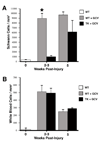Schwann cell influence on motor neuron regeneration accuracy
- PMID: 19505536
- PMCID: PMC2728180
- DOI: 10.1016/j.neuroscience.2009.05.073
Schwann cell influence on motor neuron regeneration accuracy
Abstract
Extensive peripheral nerve injuries can result in the effective paralysis of the entire limb or distal portions of the limb. The major determinant of functional recovery after lesions in the peripheral nervous system is the accurate regeneration of axons to their original target end-organs. We used the mouse femoral nerve as a model to study motor neuron regeneration accuracy in terms of regenerating motor neurons projecting to their original terminal pathway to quadriceps muscle vs. the inappropriate pathway to skin. Using a variety of surgical manipulations and the selective removal of Schwann cells in the distal nerve via molecular targeting, we have examined the respective roles of end-organ influence (muscle) vs. Schwann cells in this model system. We found evidence of a hierarchy of trophic support that regulates motor neuron regeneration accuracy with muscle contact being the most potent, followed by the number or density of Schwann cells in the distal nerve branches. Manipulating the relative levels of these sources of influence resulted in predictable projection patterns of motor neurons into the terminal pathway either to skin or to muscle.
Figures




Similar articles
-
Manipulations of the mouse femoral nerve influence the accuracy of pathway reinnervation by motor neurons.Exp Neurol. 2005 Mar;192(1):39-45. doi: 10.1016/j.expneurol.2004.10.013. Exp Neurol. 2005. PMID: 15698617
-
Applications of Proteomics to Nerve Regeneration Research.In: Alzate O, editor. Neuroproteomics. Boca Raton (FL): CRC Press/Taylor & Francis; 2010. Chapter 15. In: Alzate O, editor. Neuroproteomics. Boca Raton (FL): CRC Press/Taylor & Francis; 2010. Chapter 15. PMID: 21882439 Free Books & Documents. Review.
-
The specificity of motor neurone regeneration (preferential reinnervation).Acta Physiol (Oxf). 2007 Feb;189(2):201-6. doi: 10.1111/j.1748-1716.2006.01657.x. Acta Physiol (Oxf). 2007. PMID: 17250570 Review.
-
Role of chronic Schwann cell denervation in poor functional recovery after nerve injuries and experimental strategies to combat it.Neurosurgery. 2009 Oct;65(4 Suppl):A105-14. doi: 10.1227/01.NEU.0000358537.30354.63. Neurosurgery. 2009. PMID: 19927054 Review.
-
Re-activation of atrophic motor Schwann cells after hypoglossal-facial nerve anastomosis.Neurosci Lett. 2008 Apr 4;434(3):253-9. doi: 10.1016/j.neulet.2008.01.073. Epub 2008 Feb 6. Neurosci Lett. 2008. PMID: 18337003
Cited by
-
Neuromuscular Activity Induces Paracrine Signaling and Triggers Axonal Regrowth after Injury in Microfluidic Lab-On-Chip Devices.Cells. 2020 Jan 27;9(2):302. doi: 10.3390/cells9020302. Cells. 2020. PMID: 32012727 Free PMC article.
-
The course of recovery of locomotor function over a 10-week observation period in a rat model of femoral nerve resection and autograft repair.Brain Behav. 2020 Apr;10(4):e01580. doi: 10.1002/brb3.1580. Epub 2020 Feb 25. Brain Behav. 2020. PMID: 32097542 Free PMC article.
-
Cooperative roles of BDNF expression in neurons and Schwann cells are modulated by exercise to facilitate nerve regeneration.J Neurosci. 2012 Apr 4;32(14):5002-9. doi: 10.1523/JNEUROSCI.1411-11.2012. J Neurosci. 2012. PMID: 22492055 Free PMC article.
-
Functional recovery of regenerating motor axons is delayed in mice heterozygously deficient for the myelin protein P(0) gene.Neurochem Res. 2013 Jun;38(6):1266-77. doi: 10.1007/s11064-013-1030-3. Epub 2013 Apr 7. Neurochem Res. 2013. PMID: 23564290
-
Machine intelligence for nerve conduit design and production.J Biol Eng. 2020 Sep 9;14:25. doi: 10.1186/s13036-020-00245-2. eCollection 2020. J Biol Eng. 2020. PMID: 32944070 Free PMC article. Review.
References
Publication types
MeSH terms
Substances
Grants and funding
LinkOut - more resources
Full Text Sources

